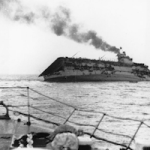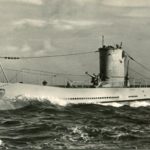In the first few months of World War II, Germany’s U-boats were tasked with blockading British ports. In carrying out this assignment, U-boat fleet commander Karl Doenitz faced two challenges. The first was a limited number of submarines – only 21 ocean-going boats were available – and the second was their vulnerability to land-based British airpower.
To meet the first challenge, production of Type VII U-boats became a priority in the fall of 1939. The boats were small and took less time to build than larger surface ships. Within a year, German industry developed a system of prefabricating U-boat parts in different locations, which sped up production. Even so, it would take more than a year to begin supplying Doenitz with the number of Type-VII’s he wanted.
To meet the second challenge, Doenitz shifted U-boat operations to the mid-Atlantic, beyond the reach of land-based aircraft.
Working in this “killing zone,” U-boats sank 300,000 tons of allied shipping during the first four months of 1940. But this success came at a grim price: 13 U-boats sunk from January through April.
British convoys, escorted by warships, made merchant shipping difficult for U-boats to attack. The Royal Navy escorts employed radar and an underwater sonic detection system known as ASDIC, to locate German submarines. The more audacious U-boat captains responded by attacking at night, surfacing their boats inside convoy formations. ASDIC could not locate a boat on the surface, and attacking from within the convoy neutralized radar detection because a U-boat was largely indistinguishable on radar screens from the ships it was attacking.
When France fell to Germany in the summer of 1940, Doenitz gained access to ports on the Bay of Biscay. This allowed his U-boats to reach the mid-Atlantic more quickly and stay on station for longer periods.
Up until this point in the war, U-boats had been operating largely on their own. Each boat patrolled a specific area, attacking merchant ships and convoys when they were detected in its combat zone. But this approach was about to change in a way that would dramatically alter the course of the war.
More in our next blog.




